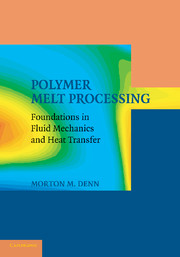Book contents
- Frontmatter
- Contents
- Preface
- 1 Polymer Processing
- 2 Fundamentals
- 3 Extrusion
- 4 Temperature and Pressure Effects in Flow
- 5 The Thin Gap Approximation
- 6 Quasi-Steady Analysis of Mold Filling
- 7 Fiber Spinning
- 8 Numerical Simulation
- 9 Polymer Melt Rheology
- 10 Viscoelasticity in Processing Flows
- 11 Stability and Sensitivity
- 12 Wall Slip and Extrusion Instabilities
- 13 Structured Fluids
- 14 Mixing and Dispersion
- Postface
- Author Index
- Subject Index
- Plate section
- References
6 - Quasi-Steady Analysis of Mold Filling
Published online by Cambridge University Press: 05 June 2012
- Frontmatter
- Contents
- Preface
- 1 Polymer Processing
- 2 Fundamentals
- 3 Extrusion
- 4 Temperature and Pressure Effects in Flow
- 5 The Thin Gap Approximation
- 6 Quasi-Steady Analysis of Mold Filling
- 7 Fiber Spinning
- 8 Numerical Simulation
- 9 Polymer Melt Rheology
- 10 Viscoelasticity in Processing Flows
- 11 Stability and Sensitivity
- 12 Wall Slip and Extrusion Instabilities
- 13 Structured Fluids
- 14 Mixing and Dispersion
- Postface
- Author Index
- Subject Index
- Plate section
- References
Summary
Introduction
The creeping flow approximation to the momentum equation, which we obtain in a formal way by setting ρ = 0 on the left side of the equations in Table 2.2 or 2.4, has the interesting property that time never appears explicitly. Thus, creeping flow solutions to time-dependent problems are quasi-steady in the sense that they correspond to the steady-state solution for the given geometry at each time. This property can be exploited to obtain analytical solutions to simple transient problems in mold filling, and the same concepts are utilized for numerical solutions to more complex problems. We illustrate the use of the quasi-steady character of the creeping flow equations with two model mold filling problems, one in injection molding and one in compression molding.
Center-Gated Disk Mold
Isothermal Newtonian Liquid
A mold to form a thin circular disk is shown in Figure 6.1. Molten polymer is fed through a small circular hole at the center of the mold (the gate) and then flows out radially to fill the mold cavity. We assume that the mold is vented, allowing air to escape as the polymer fills the cavity, so the pressure at the polymer/air interface is always close to atmospheric. The disk has a thickness H and a radius RD. The radius of the circular gate is RG. The pressure at the gate is Po, and the polymer enters with a volumetric flow rate Q; Po and Q may vary with time.
- Type
- Chapter
- Information
- Polymer Melt ProcessingFoundations in Fluid Mechanics and Heat Transfer, pp. 72 - 82Publisher: Cambridge University PressPrint publication year: 2008



